What will the cities of the future look like?
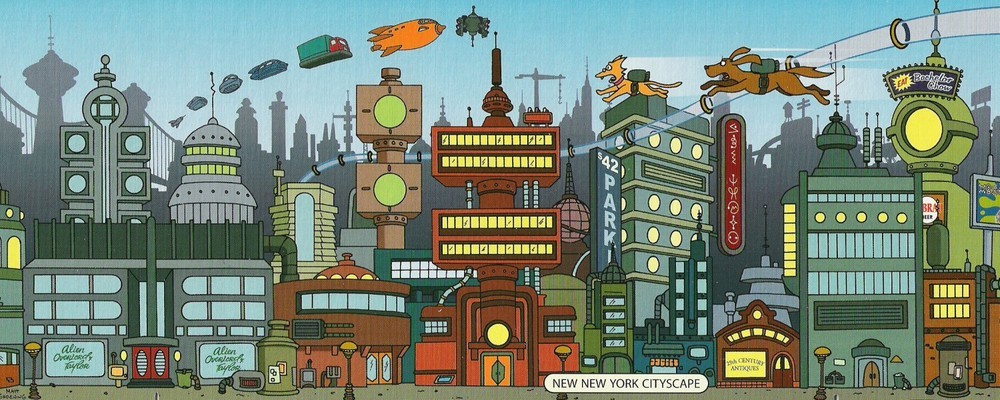
New York in 3000, Futurama .
Hundreds of architects, scientists and futurologists are looking for the answer to the question “what will the cities of the future look like, whether they will become a heap of multi-kilometer skyscrapers or go into the ground?” Against the background of the rapid growth of the urbanized areas of the Earth, the exhaustion of resources and environmental problems, the city is perceived as a real cradle of life, realizing the most courageous urban ideas and solutions.
Today, anyone can become a virtual architect: copies of real and fictional cities are being built in Minecraft, city-planning simulators of the Anno series offer to build hypertrophied versions of modern megacities on the Moon, designers draw settlement concepts that trample all modern achievements in the field of construction and transport logistics.
')
However, in addition to virtual construction projects in the world there are about a hundred real settlements claiming to be the “smart city”. In this article, together with the Real Estate Mail.Ru project, we will talk about the most interesting ones.
City Management

City of Songdo in 2020, concept.
The city of the future is a city in which most systems and infrastructure is controlled by computers. In South Korea, in the city of Songdo, a prototype of a single city information network is already being tested, which will connect all buildings into a single cluster. Information from myriad sensors and cameras will flow into a database. The purpose of this system is to control and manage all urban systems, including transportation, water supply, etc. After all, it is no secret that modern urban services are still very far from the peak of their effectiveness. In addition, the experimental system will take care of the safety of residents. For example, the floor in a nursing home will be equipped with sensors that can detect the fact of a person’s fall and send an alarm. Or a more relevant example: the citywide information network will allow the introduction of a universal card that will serve as a key to the front door, a bank card, a ticket and an identity card. Garbage truck routes will be built on the basis of data on the degree of fullness of garbage cans. And about traffic management and nothing to say, it's just musthave.

Now in many houses of Songdo, the entrance door can be opened not with a key, but with the help of a smartphone. For a few clicks you can consult with your doctor via video link. To resolve an administrative issue, you can contact the official through the application. And much more.
Songdo is located on an artificial island 50 km from the capital of South Korea. The construction of the city, which, according to third-party estimates, cost South Korea $ 35 billion, has been underway for 15 years with the active assistance of Cisco Systems. The city should be fully built in 2020, and its population by this time will be 250 thousand people. In 2016, with the commissioning of about 400 smart buildings, Songdo will be able to claim the title of the first smart city in the world.
The eternal question of traffic jams is solved radically: you can do without a car in the city thanks to a developed public transport system, as well as through the implementation of telepresence. This is expected to be achieved through the installation of TelePresence video service in each house, office and public institution, which will provide the possibility of holding remote meetings using video surveillance systems.
Songdo is also a green city, actively using renewable energy sources (solar and wind energy). Garbage is not thrown into a landfill, but is passed through a recycling system. Here they collect all the rainwater and use it for watering street vegetation, for toilets in buildings and for washing the streets.
The initiative of the Koreans are looking very closely at many countries, since their experiment can potentially help solve some of the problems of most large cities. For example, the same New York, in fact, turned into a gigantic conglomerate that swallowed up many small cities. 200 km of the coast, up to Newark itself, is one continuous development. Tokyo has already merged with Yokohama, simultaneously absorbing dozens, if not hundreds of other settlements, and 38 million people live in this colossal agglomeration. We still have no such examples, but Moscow is already close to this. In fact, it is spreading "tentacles" along the main highways, gradually integrating the surrounding cities. And how do you order to manage such complex formations?
Life without octane number

Smog in Beijing. The particles contained in smog are able to penetrate the body through the lungs, accumulate and settle in it.
It is believed that the main cause of smog is motor vehicles. And one of the main features of the cities of the future is usually terrible air. Motor transport, of course, has its detrimental effect on the air. For example, we all know how terrible is the air in Beijing, which managed to become famous for its smog and the highest level of air pollution. About 25% of harmful substances enter the air of the metropolis from transport.
Obviously, the problem of emissions must be solved - there is no getting away from it. This will probably be expressed in the gradual abandonment of internal combustion engines and the transition to electric vehicles or other types of environmentally friendly transport. In this sense, an interesting example is the city of Masdar, located in the UAE: here it is legally prohibited to use cars with internal combustion engines.
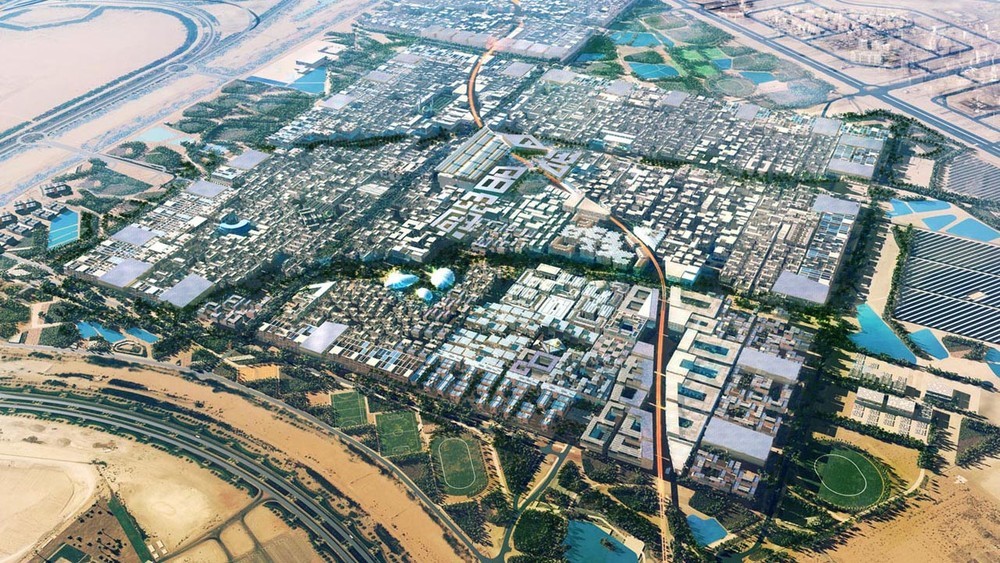
Concept of the city of the future in the UAE.
Masdar is an eco-city, 50% provided by renewable energy sources and having a sustainable ecological environment with minimal carbon dioxide emissions into the atmosphere. Scientists working on high-tech green projects and various start-ups plan to inhabit the city.
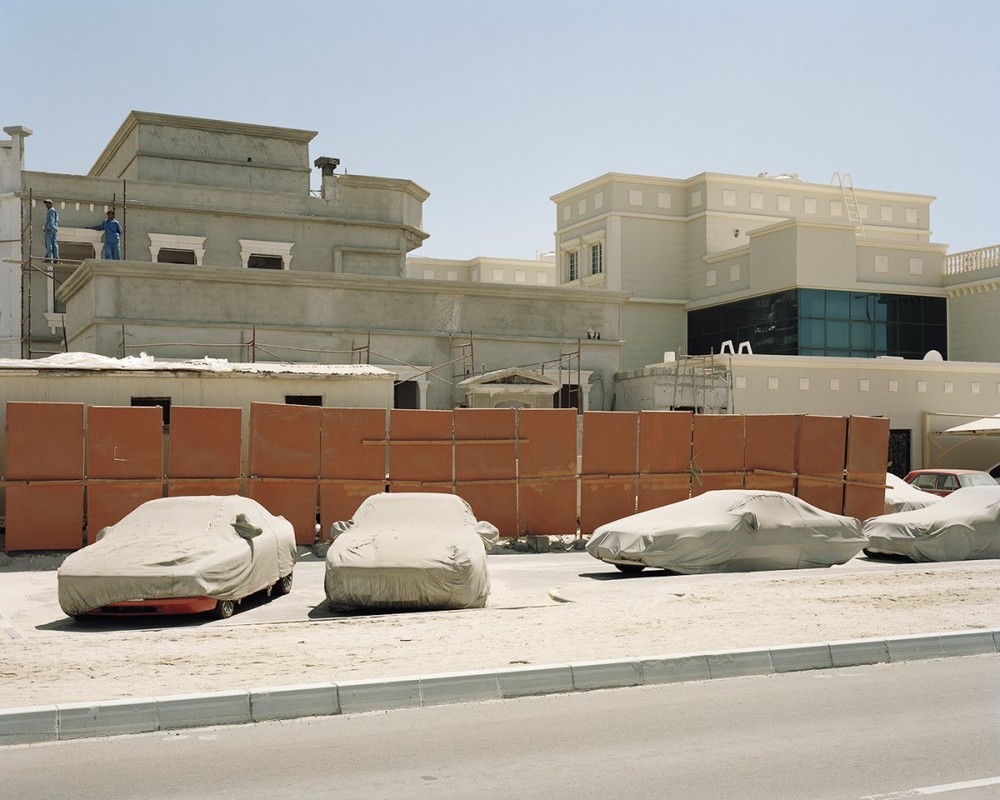
Street Masdara, 2016
The city's budget is estimated at $ 22 billion. The project, launched in 2006, was to be implemented in 2015, but due to a lack of investment, construction has not yet been completed. According to the new plan, Masdar will be erected by 2030. Now about 300 people live in the city permanently, the basic infrastructure has been built and one store is operating.

The Black Knight Transformer quadcopter is capable of delivering loads of up to 1.6 tons.
A more radical solution is the complete abandonment of the use of vehicles for the delivery of small loads. This task can be assigned, for example, to cargo quadcopters. Such experiments are being carried out in many countries, including Russia: some time ago, a pizza delivery service was operating in Syktyvkar using quadrocopters. True, the world is not yet quite ready for the massive introduction of quadcopters, but the very fact of such experiments suggests that in the future micro-winged wings will occupy certain niches.

There is another way to make the air of cities cleaner - transplant everyone on bicycles. From the point of view of costs and efficiency, this is much more convenient transport, and only walking can compete with it on environmental issues. Of course, to completely abandon public transport and force everyone to pedal will not work. In addition, despite the benevolent example of Europe, where bicycles are turning into mass transport, we will not be able to fully adopt their experience for a number of reasons, one of which is the climate in many regions of Russia. But still, in fairly warm latitudes, this is a completely realizable scenario, if you take care of building the appropriate infrastructure for cyclists and promoting this type of transport.
Cities with a predominance of bicycles will be radically different from the "classic". However, a more likely scenario of switching to electric cars or fuel-cell vehicles . Today we can not even imagine a city without cars. According to experts, soon around the world on the roads will simultaneously be 2 billion cars. So it is necessary to solve the “exhaust pipe problem” as soon as possible.
Bow city and village

This popular political slogan of the 1920s perfectly describes the approach to building cities, implying the most active use of green space. The idea is not new - such experiments were made 100 years ago, and the plans of the city parks have been drawn by futurists since the 19th century. But today, this extremely attractive idea breaks down on the harsh urban realities: as the population grows, land in cities quickly becomes more expensive, so every square meter of lawn or, God forbid, the park in the city center is the object of close attention from the builders of shopping centers, parking lots and office complexes . Unfortunately, money usually wins.
Nevertheless, any citizen would prefer to live in a green city, rather than in the stone jungle. One of the ways to solve the contradictions between the interests of business and people is the use of so-called vertical farms. In fact, these are extensive buildings consisting of several tiers, on which both park zones and hydroponic greenhouses for growing food are placed.
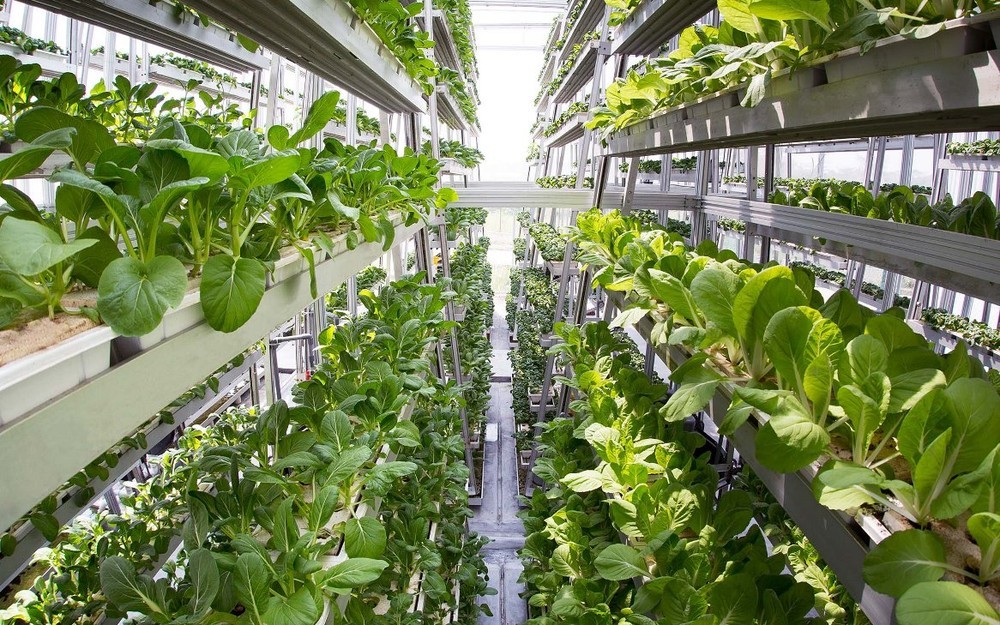
The world's largest vertical farm is now being built in the industrial zone of New Jersey. About 900 tons of lettuce leaves will be grown annually on an area of 6.5 thousand m 2 . Sunlight is replaced by special economical LED-lamps, and the earth - reusable fabric. The farm uses half the fertilizer and completely eliminated the use of pesticides.
Interest in such innovations is shown today, first of all, by agro-industrial companies. Naturally, they are most actively experimenting in this direction in Asia, where they know firsthand about the problem of land shortages and overcrowding. The advantages of vertical farms are not only in the efficient use of urban areas, but also regardless of climatic conditions, which is especially important for Russian realities. Naturally, such objects should be as computerized and automated as possible. And the fact of their placement in the city makes the architects pay more attention to the harmony and relevance of the external appearance.
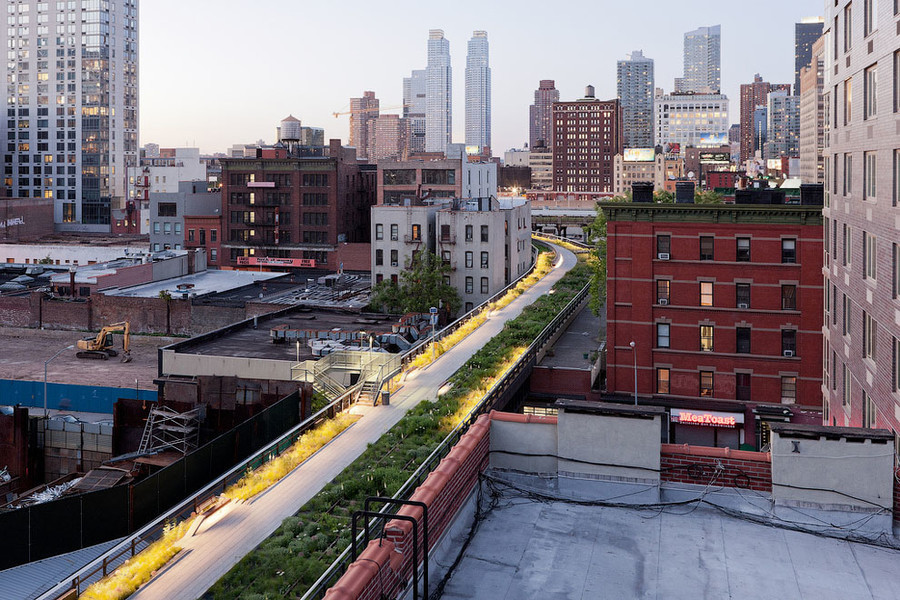
Park High Line, New York.
People do not live by vegetables alone. There are a number of bold projects involving the integration of full-fledged park areas into office and residential buildings, including skyscrapers. And in Singapore there is already a hotel, on the 56th floor of which a large park was established. For us, this is still too exotic, but the experience of New York is worth considering and, perhaps, adopting: in this city a wonderful park was laid out on an abandoned city railway line.

The concept of the park "Zaryadie", Moscow.
However, Russia also has something to be proud of in terms of landscaping projects. Thus, the “most expensive waste ground in the country”, located two steps from the Kremlin, on the site of the demolished “Russia” hotel, is now turning into a unique park, divided into several natural landscape zones characteristic of our country. A birch grove, stunted and creeping tundra plants, meadow grasses, subtropical plants, a coastal forest and steppe will appear on the territory of the park. The opening of the park "Zaryadie" will be held in September 2017.
Goelro XXI

Fujisawa, Japan.
In addition to oil and gas, modern civilization is firmly seated on the third “needle” - electricity. And all sorts of innovations of the future will require even more electricity. So, in addition to the fascinating task of turning cities into cleaner and more comfortable ones, we have to tackle the issues of increasing electricity generation and increasing energy efficiency. One of the possible approaches was tested in Japan: an experimental town of Fujisawa was built not far from the capital, in which various technologies were tested. At first glance, nothing remarkable, looks like a typical block of the American suburb, but this impression is deceptive.

Firstly, each house is equipped with solar panels and a mini-power station, which made it possible to repeatedly reduce the total consumption of the electricity supplied, carbon dioxide emissions decreased by 70%. When the external electricity supply is disconnected, the town will be able to function for another three days thanks to the accumulated electricity.
Secondly, automation is widely used inside dwellings. Washing machines themselves choose the washing program, determine the degree of contamination of things and the required amount of powder, depending on the load. If the audience leaves the TV, then after a while it turns off by itself. When a pedestrian walks down the street in the dark, the lights shine brighter, and then go back to economy mode. By the way, all cables and communications are hidden.
In this town is also not accepted to use cars with internal combustion engines. If necessary, you can rent an electric car or electric bike. The streets are equipped with numerous cameras and sensors, thanks to which they managed to reduce the number of police officers while maintaining the level of security. This year, the city will experience a system of self-managed taxis. The experiment will be conducted on the basis of several hybrid Toyota Estima minivans.
Conclusion
According to the World Health Organization, by the middle of the century, the urban population will be 70% of the population — over 6 billion people. So, in any case, we will have to learn how to effectively solve the numerous problems of managing huge urban agglomerations. Yes, and "ordinary" large cities will benefit from the introduction of new technologies, allowing to make the life of citizens more comfortable and safer.
Fortunately, most of the actual ongoing projects have nothing to do with anti-utopian ideas about the world. The epoch of cyberpunk with cities, one kind of which plunges into a severe depression, either has already ended, remaining on the pages of books and in film shots with special effects, or postponed to a distant future, the development scenario of which is associated with unpredictable events.
Source: https://habr.com/ru/post/396105/
All Articles